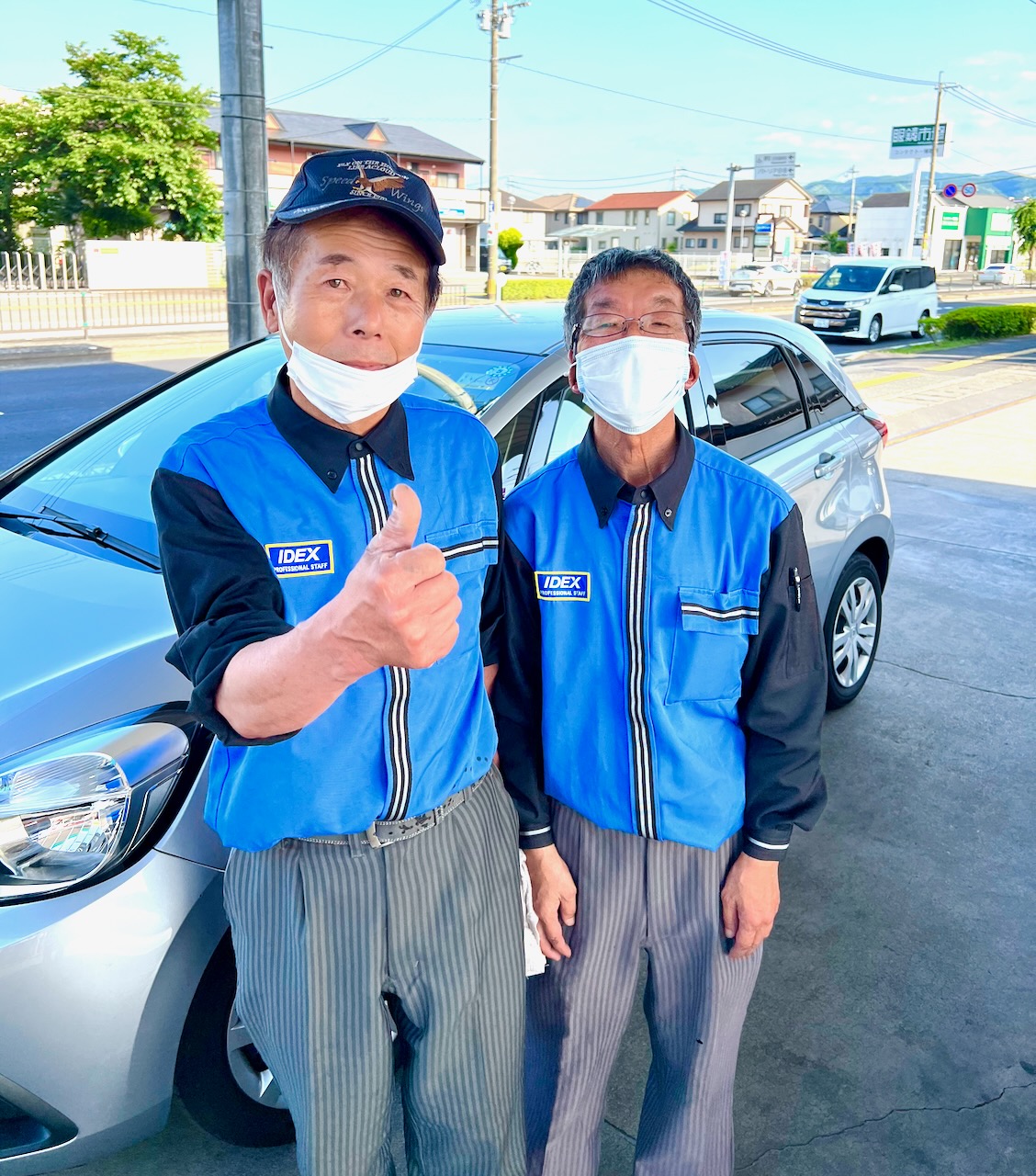

IMPORTANT NOTICE!
When I first started sending out my newsletters I had two “groups”. One group was for finance and travel topics. The other group was for my trackchasing and travel fans. Some folks belonged to one group or the other and some to both newsletters.
Over the course of a few years, the topics of finance, travel, and racing have sort of “merged”. Just about every message I send has a little bit of finance and money-saving features as well as travel topics and racing. With that being the case I am going to consolidate everything I send into ONE newsletter. I hope this works for everyone and that you find something interesting, entertaining, and worthwhile in everything I share with you.
Thanks very much for your interest. Remember, you can easily unsubscribe anytime you want…but I hope you don’t feel that need. In the meantime why don’t we travel to Japan!!
Japan! Part 3 of 3…Fukuoka!
FRIDAY
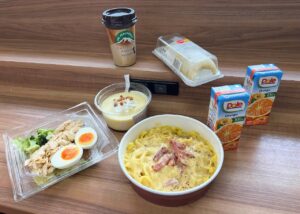
Normally, when I stay in a Marriott, they give me breakfast for free. Not in Tokyo. Since breakfast was $60 U.S. for two each morning we didn’t think that was a good value. Instead, Carol and I commonly had breakfast at a convenience store just 100 meters from the hotel. Cost? About $10 for two people.
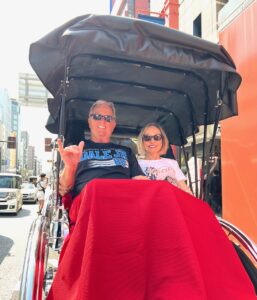
We reinvested the savings in a souvenir baseball T-shirt, three theater tickets, and a rickshaw ride. We are common sense people at heart. Who in their right mind wouldn’t actually prefer spaghetti drenched in garlic, and a cream puff for breakfast anyway?
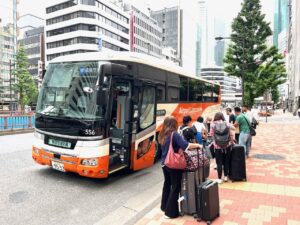
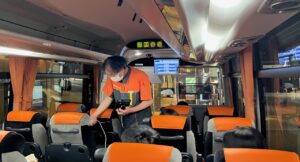
“Limousine buses” are an excellent way to get to and from downtown Tokyo’s two airports, Narita, and Haneda. These are large, new luxury buses. I’ve ridden them many times.
I checked Uber for a ride to the airport. The fare to take us from our Tokyo downtown hotel in the Ginza section of the city to the Narita Airport was $208. Instead of doing that, we chose the airport limousine bus. The bus stopped right in front of our hotel for a charge of about $21 per person. The bus stopped at one other hotel on our way to the airport. All of our luggage was handled for us by the bus driver.
Although it didn’t seem like it up to this point, this IS a trackchasing trip. Of course, every trackchasing trip has us stopping to see racing at one track at a minimum. Make sense?

The racing venue I picked would be the Autopolis International Racing Circuit. I’ll tell you more about that facility when we get there.
Just getting to the race track would provide its share of challenges. If we had driven from Tokyo to the track that would have been a 15-hour and three-minute drive. That didn’t seem like a particularly good idea. If I had been on my own I might have tried it for the experience. With Carol along for the ride that wouldn’t be a good idea. Sometimes she doesn’t get the same “kick” out of some of this as I do!
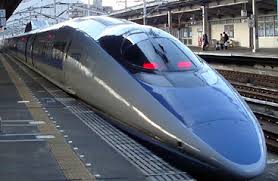
I investigated Japan’s bullet train. The train would take slightly longer and be more expensive than taking an airplane from Tokyo to Fukuoka. Trust me, if I have not already ridden on a bullet train in Japan, and the super-fast train in France, we would have been riding the bullet train!
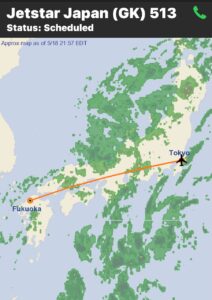
I was really surprised when I discovered Jet Star Japan’s (not the same as Jet Star Australia) low fares for their two-hour one-way flight. I think we paid less than $200 per person for our round-trip airfare from Tokyo to Fukuoka. That included two checked bags, exit row seats, and pre-paid food, drinks, and snacks on the plane.
Why do I “think” we paid less than $200 per person and not know for sure? I made the reservation a few months ago. I honestly can’t remember what we paid but it was super cheap.
We would be flying out of Japan’s Narita Airport. This would require some planning because, on the return to Tokyo, Carol would be flying from their OTHER airport, Haneda back to Los Angeles. I would be flying from Narita Airport, not Haneda, onto yet another international destination to continue my trip. Yes, I think we can safely call ourselves adventure travelers.
We had some excess luggage. We didn’t want or need to haul that baggage from Tokyo to Fukuoka. I came up with a solution for that particular problem. We would store our excess luggage in some lockers at the Narita airport.

The fee for storing two pieces of excess baggage in an airport locker would be less than what the airline would charge us to check that same baggage round-trip on the plane. More importantly, we wouldn’t have to “lug around” that baggage on subways and the like.
It sounds pretty simple to ride a bus from the hotel to the airport, then take our excess luggage and put it in a locker and close the door of the locker and move on down the road. Stuff isn’t easy in foreign countries. Things are definitely not easy in a country like Japan where few really speak or understand English and the signs are mainly in Japanese.
However, when I can’t figure things out, I immediately track down somebody who can solve the problem. I then let them do the mental and/or physical work. That’s just me. I am not one of those men who, no matter what will not ask for directions or help. This process works well for me. When I get other people to do stuff for me, Carol is always amazed.
Today, after struggling to fit our huge pieces of luggage into relatively small lockers, and also struggling to figure out how we were going to navigate the payment system I enlisted the help of four Japanese men.
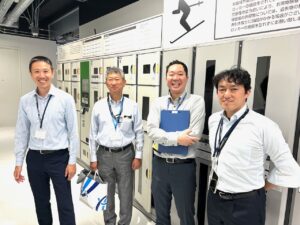
They looked like professionals. The men had lanyards around their necks as if they worked in some capacity at the airport. They were more than up for the challenge and followed me 50 meters to where the lockers were.
This was sort of the equivalent of having four Japanese MIT engineer graduates working on the problem. Wouldn’t you know it? We had placed our luggage in the locker that could only be operated with a Japanese credit card. We didn’t have a Japanese credit card.
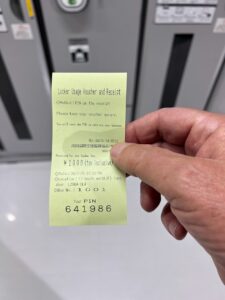
These guys soon discovered that if we moved our luggage to the locker next door we could pay cash. We ended up paying one thousand Japanese yet or about seven dollars to hold our space in the locker. Then if we returned within five days, which we expected to do, we would pay the balance based on how long our luggage had been in the locker. I can tell you this. Carol and I might still be standing in front of those lockers and not understanding that some took credit cards and some took cash. We grabbed our “pin code” and off we went.
We expected the storage cost to be about $50 U.S. for three days of storage. Again, that’s less expensive than what the airline would charge us and a lot more convenient.
I have flown Jet Star Airlines, which is partially owned by Qantas Airlines, in Australia in the past. They are cheap and efficient. That was the case today with our flight from Tokyo’s Narita airport to Fukuoka. Of note is that Jet Star Japan is different that Jet Star Australia but as a passenger that would be difficult to notice.
The flight attendants were aware that we have paid in advance for a drink and a snack. I wondered how they were going to handle that. When it came time to serve everyone our name was on a “list”. Jet Star Japan is a pay-as-you-go airline. I like that kind of business model.
When we landed in Fukuyama, we discovered a very modern airport. One of the advantages of this airport is the subway is located on the lowest level of the airport. We didn’t plan on using the subway from the airport. I had a different plan.
I had reserved a rental car for our three-day stay in Fukuoka. The cost would be a reasonable $150 U.S. Our hotel had mentioned they did not have on-site parking. That was going to add to the complexity of having a rental car. We really only needed the car for one day. That would be the day that we drove five hours round-trip out to the race track and back.
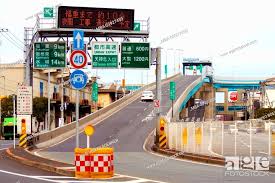
I started thinking once we landed that we didn’t really “need” a car for three days when I only planned to drive it one day. I didn’t have a place to park the car for three days. It was going to be a supreme challenge driving in Japan on the left side of the road but more importantly, with a highway sign system that was not English-friendly. I was starting to panic.
I rarely if ever panic. That just doesn’t do any good. I use the scientific method. I try to assess the available options, pick one of those options and implement that option. That has always worked for me.
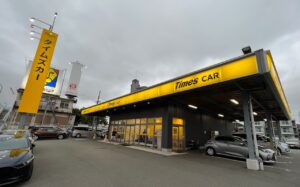
It was a 15-minute walk outside of the airport to get to the rental car agency. Once I arrived, I asked them if I could change my reservation from three days to having the car for only one day on race day which was Sunday.
To my utter amazement, they were willing to let me do that. Renting the car on Sunday only would cost us ¥7700 or about $56 U.S. I didn’t change the reservation to save money but that was a benefit. More importantly, I wouldn’t have to worry about where to park the car when we were not using it. I figured if I could pick the car up on Sunday morning and drop it off Sunday night after the races we would not have to park it anywhere other than at the racetrack.
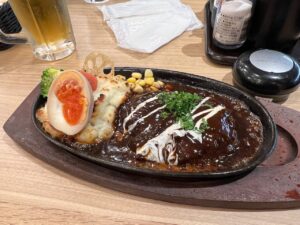
Now the rental car situation was “sorted”. We walked back to the airport and had a delicious meal at one of their upscale restaurants.
I am always looking for “opportunity”. Carol calls me an “opportunist”. When she says that I remind her that she is the direct beneficiary of my having that skill. Opportunity can rear its beautiful head in all sorts of situations and timings.
Most service people in Japan, and most Japanese people do not speak a lot of English. That’s not a criticism but an observation. Of course, in America almost nobody speaks anything but English if they are native English-speaking Americans.
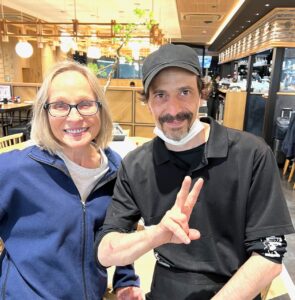
When we had a little bit of trouble communicating with our server at the restaurant, a man came to our table dressed in a restaurant uniform. He spoke English very well. It turned out he was the cook! The staff had seen that we were probably going to need some help and he volunteered.
This guy was great. We learned he was originally from Quebec and had moved to Japan for a short-term stay and ended up marrying a Japanese woman. They now have four children and have been living in Japan for 15 years!
It’s a pretty good deal when you go to a foreign restaurant and you have the chef come out to your table about seven times to talk with you and deliver your food dish by dish. He told us he added just a little bit extra to all of our offerings that were not on the menu. Our food was delicious.
I mentioned to our culinary friend that we were planning to rent a car for one day on Sunday to go to the race track. I told him that I would just as soon hire a driver for the chore. I didn’t know if I would be able to pull that off.
He told me that if he knew anyone he would give me a call. He said that if he wasn’t working Sunday, he would drive us himself. I’ve got a feeling, but this is just a feeling, that we’re going to get a call from this guy with a solution to our problem. If we don’t I’ll be renting a car in Japan!
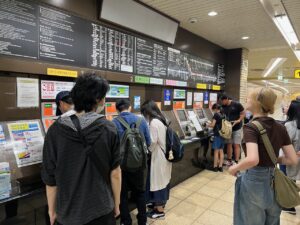
The new plan, without a car, had just been developed in the last 30 minutes. Now we would be taking the subway to our hotel. That was inexpensive, only about $3.50 for the two of us. When we got off the train the walk was just five minutes to our hotel.
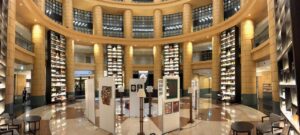
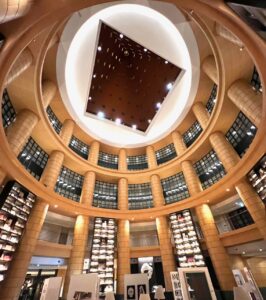
For the next three days, we would be staying at a place called the “Basics Fukuoka. This was a high-quality hotel with a beautiful lobby shaped like a huge circle with a ceiling that must have been several stories tall.
Transitioning from Tokyo to Fukuoka had come with its own set of challenges. These “challenges” are what make our trips so exciting. We know what we want to do, but we know there will be obstacles. Some obstacles will be bigger than others. Language and signage were the main issues in Japan. Language and signage would make achieving the objective of getting from point A to point B just a little bit more challenging. We don’t use tour guides. We are our own tour guides.
We have a plan for our three nights in Fukuoka. We have Saturday for touring. Sunday is reserved for the race. On Monday, we will fly back to Tokyo. On Tuesday Carol will fly back to SoCal and I will head in the opposite direction. More on that later.
SATURDAY
Today would be our only day to tour Fukuoka. We weren’t exactly sure what the plan of the day was. There didn’t seem to be anything all that compelling to see.
We are noticing one thing that is inconvenient about our trip but there isn’t much that we can do about it. What would that be? I’ve mentioned this a few times.
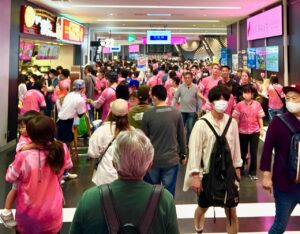
Virtually no one of any age speaks much English. Why? I’m going to guess it’s because Japan doesn’t really get very many American English-speaking tourists. We’ve seen and heard virtually none after having spent more than a week in Japan. If no one is speaking English, then the local people don’t have any practice with that language.
I would have thought that younger people would have studied some English. English is the universal language, right? If they have done that, then the teaching wasn’t very good! We have struggled with just about every conversation. We walked away from most conversations feeling that we were not understood, and don’t have the information that we wanted to get.
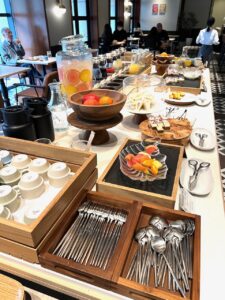

We had a nice breakfast at the hotel this morning. Everything about our hotel is high-quality. The only drawback to these lavish hotel breakfasts is that you can really blow your calorie budget for the day. At least I can!
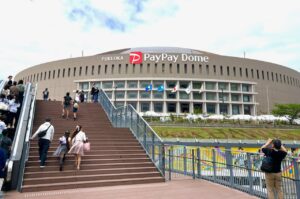
We decided we would walk over to the PayPay Dome in Fukuoka to see if we could get tickets for today’s Japanese major-league baseball game between the Soft Bank Hawks and the Saitama Seibu Lions.
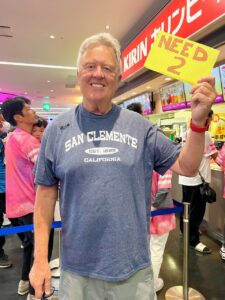
If the event was sold out for the Saturday afternoon, 2 p.m. start, I was prepared to use my “need two” sign. I had no idea how effective that would be in Japan.
The PayPay Dome opened in 1993 and seats 40,000 people for baseball. Surprising to me was that the PayPay Dome was the very first entertainment venue to offer a retractable roof in the world. That’s impressive.

Musical artists like Elton John and Michael Jackson and the Rolling Stones have played inside the dome. I know the Japanese people are big fans of rock stars.
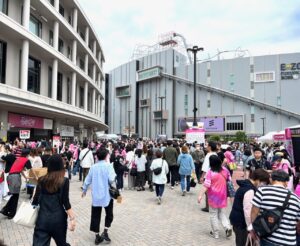
Today’s weather was a beautiful 75°. With a nice breeze off of the water and lots of sun, this was have been a good game to see in an outdoor stadium. Japanese people love their baseball. Today the area was packed with fans getting ready to see the big game.
We were able to buy our tickets the traditional way at the ticket booth at the stadium. How boring, right? Conversing with the ticket seller behind a bank teller like the bulletproof glass was nearly impossible. I didn’t really have much idea how much the tickets were going to cost. We ended up with some premium seats in the lower level behind home plate for a price of $103 per seat. I never pay anything close to that her baseball tickets are virtual any other ticket for that matter.

I had checked StubHub and the ticket prices for today’s game came in at $107 each. Then I checked the game for next week. Tickets for that game were priced at $35 each. I had no idea if today’s game was special for any reason or not.
We were just happy to be able to get tickets in a situation where it appeared there might not be any available. Our seats were fantastic.
We are noticing all kinds of examples where the Japanese people made their society look enviable. People were all polite, dressed well, and fastidious. Never in any of our travels all around Tokyo and now Fukuoka did we feel unsafe. Never.
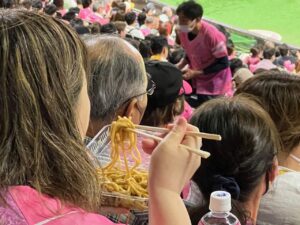
At today’s game, a guy sitting with his wife two seats away from me caught a foul ball barehanded. That was impressive. What he did next was even more impressive.
The guy had to be in his 50s and maybe more. He simply stood up and caught the ball two-handed. Then just as casually as if he were sipping a Coke he put the ball in a bag that he had next to his seat. He never looked at the ball again during the entire game. Even Carol was amazed at his nonchalant behavior. If I had caught that ball it would have never left my hand for the rest of the day!
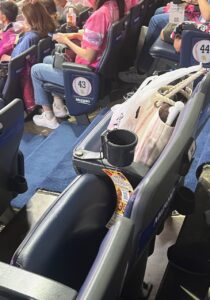
Shortly after he caught the ball, the man and his wife packed up all of their gear and put everything in a bag. Then they got up and left the bag on their seat. Off they went for about 30 minutes to get some food and drink.
Who in their right mind in the United States would go to a major league baseball game and leave their valuables in a cloth bag, including a recently caught foul ball while they went away for a half hour? We found the safety, security, and trust amongst the Japanese population to be nearly beyond belief. I suggested that Carol reach in and steal the ball. She didn’t think that was a good idea. Nope. Carol is not nearly as adventuresome as me.

The PayPay Dome was just about identical to the Tokyo Dome, where we saw a game a few days ago. Those places could be twins. The roof does not retract at the Tokyo Dome. The roof does retract, but it wasn’t retracted, at the PayPay Dome.
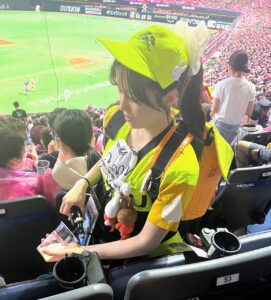
The crowd was loud continuously throughout the game. The atmosphere is much different than a baseball game in the U.S. Young women concessionaires roamed through the stadium selling beer from coolers strapped to their backs. They even had women selling Baskin-Robbins ice cream in the stands. Notably, ALL of the food and drink vendors were women.
The game wasn’t the most exciting I’ve ever seen. There was no score until the eighth inning when the Seibu Lions finally pushed across one run to take the lead. We left after the 8th inning to avoid the rush. The final score was 1-0.
I had read that a visit to Canal City sections of Fukuoka might be a good place to visit and a great place to find some dinner. I used Yahoo Maps to direct us to a bus that would take us from the stadium in the general direction of Canal City.
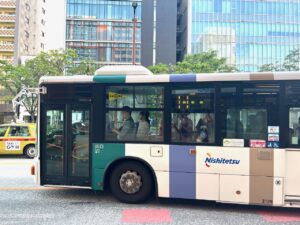
We hadn’t ridden any buses on this trip. We had no idea what the “protocol” was. We boarded the bus just as if we were Chevy Chase in the movie, The Griswolds, and immediately created a ruckus.
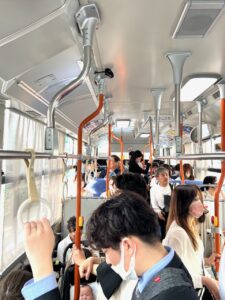
It took some English-speaking people in the back of the bus to inform us that when you get on the bus you grab a small paper ticket. Then, when you get off the bus, you pay with exact change, based on how far you traveled. It certainly goes without saying, but I’ll say it anyway, when signs are not in English you’re operating on a wing and a prayer. Was I embarrassed with our rookie behavior? Not in the least. I didn’t know any of these people!
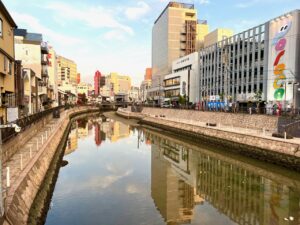
We finally made it over to the Canal City area. We enjoyed the walk. We found the enclosed shopping and dining areas to be most similar to our travels in Istanbul, Turkey.
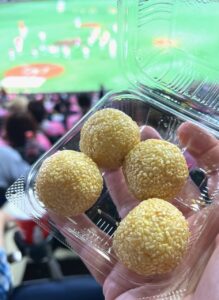
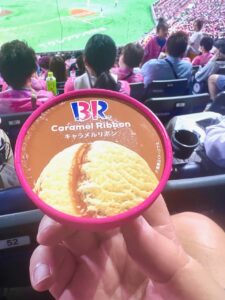
We had eaten very little at the ball game. At the game, we started with an order of sesame balls and finished with two cardboard cups of Baskin-Robbins ice cream. When was the last time you went to a sporting event and dined on those choices? After the ball game dinner was the top priority!
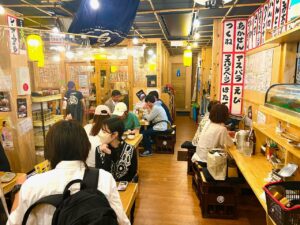
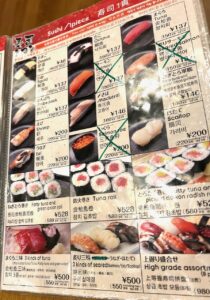
We found a very authentic Japanese restaurant. The only food that we don’t eat is sushi, and there was a lot of sushi on this menu. Why no sushi? I don’t think they cook it enough. See what I did there?

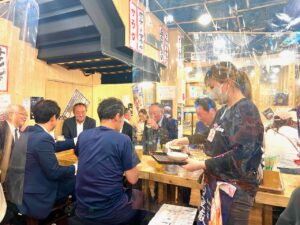
Nevertheless, we pointed at the pictures and soon had a very complete order of teriyaki shrimp and artichoke, some fried cheese, and a plate of sausages. We people-watched a small group of Japanese businessmen in suits. The cultural experience was better than the food but it was all good.
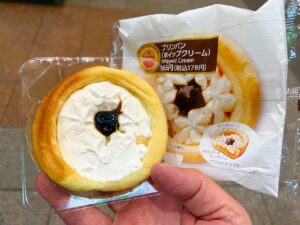
When dinner was finished we stopped at a Family Mart convenience store for some Coca-Cola Zero and sweet pastries. No sugar/no calories sodas are almost nonexistent in restaurants and ballparks. The only place you can buy these drinks is in Japan’s convenience stores. I’ve been having some form of sweet about 4-5 times per day. I love their fresh cream pastries. I don’t even want to think about jumping on a scale when I get home.
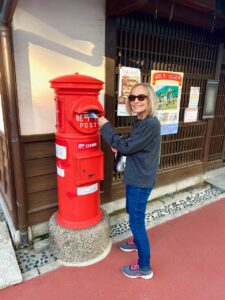
The weather was now beginning to cool off but it was still very comfortable. Google Maps told me that we could walk back to our hotel in 27 minutes. There was no rush. Carol found a mailbox and mailed her postcards. We took our time and walked through the downtown area of Fukuoka. We were back to the hotel by 7:30 p.m. Like every one of our days in Japan we could easily say we had a full day.
Tomorrow is a big day as regards trackchasing. I’m going to rent a car and attempt to drive on the left side of the road using the Google Maps GPS system on my iPhone. Virtually none of the road signs will have anything to do with English. For the most part, reading the signs is a losing battle.
I have driven a car in both England and Australia on the left side of the road for tens of thousands of miles. As you know both of those countries are English-speaking. This will be the first time I have ever attempted to drive on the left side of the road in a country where I cannot read the road signs. We’ll see how that goes. I’m looking forward to the challenge.
SUNDAY
Today was going to be the biggest day of the trip. I don’t say that for what might seem to be an obvious reason. Yes, Carol and I were headed to the Autopolis International Racing Circuit to do a little trackchasing. It wouldn’t be a trackchasing trip if we didn’t trackchase, right?
What truly made this the biggest day of the trip was the idea that we would be renting a car in Japan. In Japan they drive on the left. That was no big deal to me.
On past trackchasing adventures I have driven tens of thousands of miles in England, Australia and New Zealand. I’ve likely driven in a Caribbean country or two that I have long sense forgotten about. Driving on the left? Not a big deal.
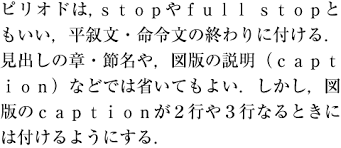
However, all of the signs in Japan would be in Japanese. Duh! Japanese alphabetical characters are like nothing that an English-speaking and reading person would ever encounter in their daily lives.

I had reserved a car for three days for our visit to Fukuoka. Then when we arrived on Friday night I chickened out! I told myself it wasn’t going to be convenient to park the rental car. I told myself we really didn’t need a rental car for three days but only for today when we be traveling outside of the city of Fukuoka.
More than surprisingly, I was able to convince the Times Rental Car people to let me change my reservation at the last minute without penalty from three days to one day.
I have to be completely transparent with you. I actively pursued the idea of hiring a driver to take us to the races today. My three-day rental contract was going to cost us $150 U.S. I figured I could take that $150 and hire a driver to take us up to the Autopolis International Racing Circuit. The trip would have a round-trip driving time of about five hours plus the time we would spend at the race.
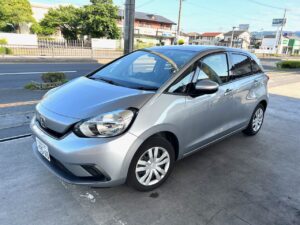
Alas, after a somewhat half-hearted personal driver search, I resigned myself to the idea that we would be renting a car. The rental car would have a steering wheel on the right side. The gearshift would be on the left side. Finally, I would be driving on the left side of the road trying to comprehend the more than confusing Japanese language barrier, and highway system.
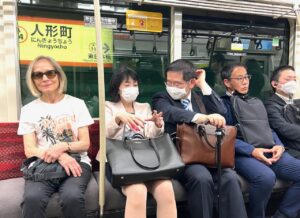
When we landed at the airport on Friday night I changed the rental car reservation. Then, we simply took the subway system to within about 500 meters of our hotel. That was quick, inexpensive, and convenient. Saying the subway in Japan was easier and more convenient than renting a car took a lot for me to say!
On Sunday morning, race day, I plugged in the “Fukuoka airport location” into Google Maps. I saw no mention of the subway. They were recommending a bus. I didn’t think riding the bus was as good as the subway. Why would they say “bus” rather than “subway” when we had ridden the subway from the airport to the hotel when we arrived? We also had a walking option. Without any bags, the walk would be relatively easy, only 29 minutes in length.
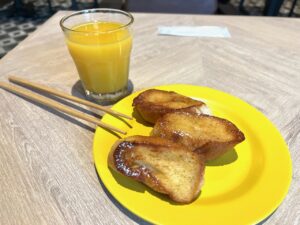
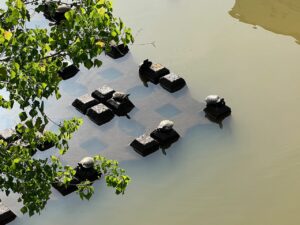
So, after a hearty buffet breakfast at the hotel (where I ate huge quantities of French toast every morning) and using Google Maps, Carol and I started walking toward the airport. It was a beautiful cool spring day. We passed one canal. The canal was full of turtles sunning themselves on rocks. There were huge carp swimming back and forth.
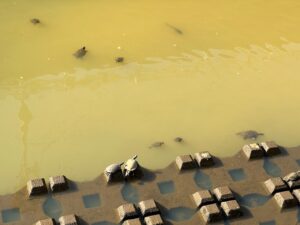
Not every good plan has a good outcome. We kept walking and walking and nothing seemed all that familiar. We did see a lot of turtles! When you travel in foreign countries it’s easy to make an assumption that one thing will happen when exactly the opposite will occur. This is really all about the learning curve.
When we landed in Fukuoka from Tokyo on Friday, we arrived at the domestic terminal. Of course, without my knowing it this morning, Google Maps was now directing us to the international terminal. Who would have known that?
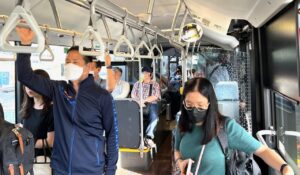
It also just turned out at the international terminal at the Fukuoka Airport was probably two or maybe three miles from the domestic terminal. The directions from Google Maps were directing us to the international terminal. The Times Rental Car location was across the street from the domestic terminal. When we arrived at the international terminal I realized my error. At that point, we hopped on an airport terminal transfer bus at the international terminal that would take us to the domestic terminal and our rental car. That’s how I knew that the international terminal was three miles from the domestic terminal! Carol was very patient with the process. Yes, we had a nice walk!
Once we were at the domestic terminal we knew the rental car location would be another ten-minute walk. We had been there on Friday night when I changed our reservation to a one-day rental, rather than three, beginning today.
There were a few things to sort out to make our rental car experience, the most productive. We were only paying $56 for a one-day rental. That was a bargain and much less than I was likely to pay the United States right now.

Last night I did a little research on the subject of “tips for driving in Japan” l. There would be toll roads. We would need to either pay in cash or get a toll transponder pass. The transponder would allow us to pass toll collection points without stopping. For just ¥330 or about two bucks the car rental people rented us a toll pass. We would pay that small amount and just cruise through the toll booths.
We might be experiencing a little bit of a cash crunch as regards our supply of Japanese yen. When we left on this trip, Carol asked me how much money in U.S. funds we might need in Japanese yen. I threw out the number of $500. If you were to come to Japan for a 12-day vacation, would you bring more than $500 in local currency? I thought you would.
I would be paying for our rental car with our Chase Sapphire Reserve Visa card. When I do that Chase acts as my primary auto insurance carrier.
It was explained to me that if we went with my credit card insurance and ended up totaling the car I would be responsible for the entire replacement cost of the car. I could have said, “No problem. Visa will take care of that”.
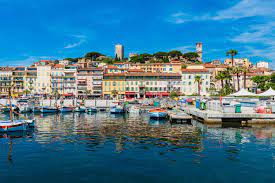
On a trip to Cannes, France (above) with Carol several years ago we were involved in a fender bender. A guy ran into the back of us. The accident was his fault. Nevertheless, when using our credit card insurance to cover the cost of repairs, it was a paperwork nightmare and a hassle. Today for just 20 bucks, I could put us in a position of having zero liability if we crashed the car. I knew that if I didn’t pay that $20 and I had to go through that paperwork hassle I would surely have regretted my decision. We paid the $20 U.S. and had no financial liability for the car.

It took the rental car agent a little bit of time to get us familiar with the car’s GPS system. We would use our Google Maps GPS as a backup. Luckily the rental car had Apple “CarPlay” software. Our Google Maps option would play on the car’s video screen.
I never like to listen to folks who verbally project negative future outcomes. The female voice on the GPS system did that constantly. She was telling me not to drive the wrong way on any of the streets we took. I hadn’t even thought of doing that! She reminded me to take a break from time to time. Oh my. I don’t care for folks who project negative future outcomes.
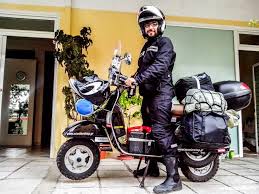
This is not to say that I would NEVER drive the wrong way on a one-way street. I hadn’t done such a thing since I was in Uruguay. There I ended up paying a $175 fine for driving the wrong way on a one-way residential street. What were the chances in a Uruguayan residential neighborhood there would be a copper dressed in civilian clothes riding a Moped who would nab me? Now driving the wrong way on a street was all I could think about!
I would have to say that every day that we’ve been in Japan for the past eight or nine days, we’ve had a major activity or attraction to fuel much of the day. That’s nearly a requirement for every day I vacation. I want SOMETHING happening every day of the trip. On this Sunday, there would be no exception to this policy.

I think today might have been the most challenging touring day that I’ve had in a very long time. We rented a Honda Fit automobile from the Times Rental Car agency. Whenever I drive on the left side of the road it definitely requires a different level of attention compared to if I were driving back home in the United States.


Today’s racing would take place at the Autopolis International Racing Circuit. Japan has a national racing series for the “Super Formula” racers. Super Formula racing is a notch or two down from Formula One racing. The cars in these two series are pretty much identical.
Of course, I have a video from our racing experience at the Autopolis International Racing Circuit. This is Japan’s famous racing series, Super Formula. Let me just put it this way. If, after watching this video, you do NOT feel as if you went to Japan to see Super Formula racing in person I will refund every penny you have ever paid to watch my videos. Heck! I’ll double everything you have ever paid. You can’t beat an offer like that. Here’s the link to our racing day at Autopolis.
I don’t even want you to think about what it took to film the opening scene. Just the thought of my driving on winding two-land mountain roads in a right-side steering car on the left side of the road and filming a motion picture could conceivably leave you emotionally scared for life. Just enjoy the film without thinking about what it took to make it.
Autopolis Super Formula racing…all the way from Japan
This is what Wikipedia told me about the track and its history.
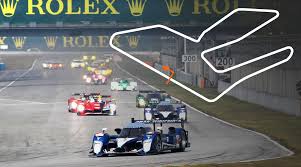
Autopolis (オートポリス, Ōtoporisu) is a 4.673 km (2.904 mi) international racing circuit located near Kamitsue village in Ōita Prefecture, Japan on the 30 km (19 mi) northeast of Kumamoto. Opened in 1990, it hosts a range of domestic and international motorsport events throughout the year. The track is noted to have a high standard of facilities and infrastructure. Due to the circuit ending up in financial difficulties, it has changed hands several times but still operates to this day.
History
The circuit, located within Aso Kujū National Park, was built at a cost of $500 million by the wealthy real-estate developer and investment banker Tomonori Tsurumaki who made headlines in 1989, when during a Paris auction, he successfully bid a Pablo Picasso painting Les Noces de Pierrette for $51.3 million from his Tokyo hotel room. Following his successful bid, he announced that his painting was to hang at the art gallery of the auto racing resort, under development at the time.
Tsurumaki ordered 30 Buick powered US built single seater race cars called “Sabre Cars” for a race to take place on his circuit’s grand opening, on November 1990 consisting of a mixture of invited U.S. CART drivers such as Stan Fox, Johnny Rutherford, Dick Simon, Gary and Tony Bettenhausen, against local Japanese drivers. After the grand opening, Tsurumaki planned on a series with the cars, known as Formula Crane 45. A few races were run in 1991, with only a handful of cars competing.
The only major international race held at Autopolis was the final race of the 1991 World Sportscar Championship season, the 1991 430km of Autopolis, which was won by Michael Schumacher and Karl Wendlinger in a Mercedes-Benz C291 fielded by Sauber.
To promote the venue’s intention to host a Formula One race, it sponsored the Benetton Formula One team in 1990 and 1991. The cars featured prominent Autopolis logos. Visitors to the WSC event criticized the track for being too remote to the hotels which required a several hours bus ride and felt that it was unsuitable for an F1 race.
Following the bankruptcy and collapse of Tsurumaki’s company Nippon Tri-Trust in 1993 (the year the track was supposed to hold an F1 race), the circuit and other assets he owned ended up in the hands of Hazama who was responsible for the construction of the race track. Ultimately, the track’s F1 event slot for the Asian GP on 11 April 1993 was given to Donington Park, and TI Circuit Aida would host a second Japanese race in Formula One calendar in 1994, but suffered from the same location-related criticism and was removed at the end of the following season.
By 1995, the company offered the site for sale at 10% of its build cost which consisted of three hotels, swimming pools and an artificial ski slope. Some of Tsurumaki’s assets, such as paintings, remained in a bank vault waiting to be sold.
Autopolis was purchased by Kawasaki in 2005.
The circuit
The circuit is located in an upland area of the island which means the air is thin with low atmospheric pressure, similar to Autódromo Hermanos Rodríguez in Mexico City. It has an elevation change of over 50 m (160 ft) with the first section generally downhill and the latter part of the course runs uphill. The start/finish straight is located at an altitude of 820 m (2,690 ft).
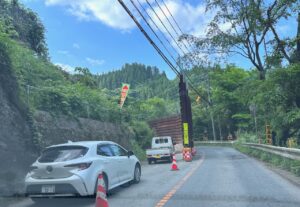
I can understand why this track was never able to get on the Formula One race schedule. The last twenty miles or so to get to the track are on winding, narrow, mountainous roads.
I tried to buy some discount race tickets at the local convenience stores last night. I was unsuccessful primarily because virtually nobody in Japan speaks, and or understands, English very well.
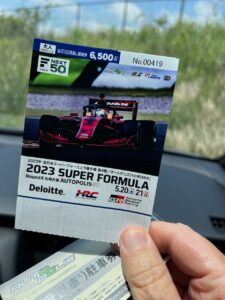
When we pulled up to the ticket gate today tickets were selling for ¥6500 or about $47 U.S. We paid another ¥3000 for parking. That ¥16,000 yen expense put some serious doubt over our remaining Japanese currency supply getting us through the rest of the trip. We’re going to make it home but we won’t have a lot of local currency in our pockets.
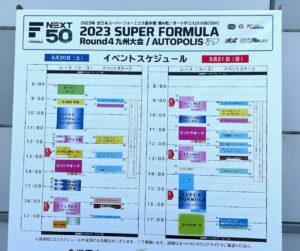
The support series racing today was called Super Formula Lites. They started just 11 cars. I suspect the cars they use today were the Super Formula cars that raced in recent years.

The most enjoyable thing about attending a race like this for me is just soaking up as much ambiance as I possibly can. Carol and I walked all over the track with the exception of the paddock. That was off-limits to fans with our type of ticket.
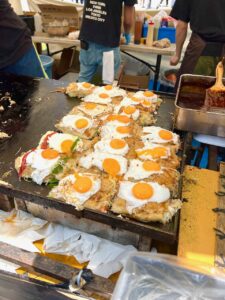
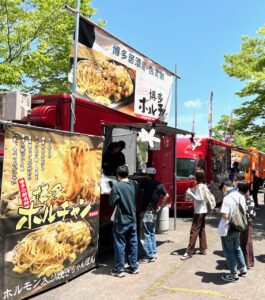
It was a real kick to check out the food offerings at the track. I was surprised to see a hamburger food trailer and another food trailer selling Japanese-style burritos.
Most of the stands were selling combinations of fried noodles, bean sprouts, and chicken cartilage. I might have liked to have tried the chicken entrée but the word “cartlidge” just didn’t fit well in my wheelhouse.
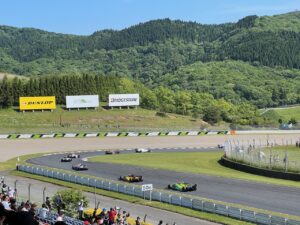
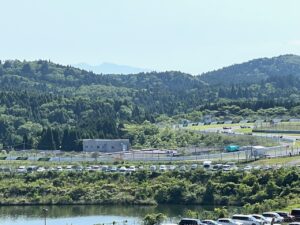
The big drawback, from my point of view, is that fans can’t see very much of the racing on these large road courses. This is the same reason I don’t care for racing at the Indianapolis Motor Speedway. Today we sat in a grandstand that had a panoramic view of much of the track. We could see the cars race for about 45 seconds of their lap. Seeing just that much is dramatically more than can be seen at most large road course venues. At Indy, a racing lap takes about forty seconds. Most seats at IMS will not allow you to see more than about ten seconds of that 40-second lap. No, that type of racing is not for me.
We took a shuttle bus just to get a sense of what the track was like from that vantage point. There was a huge section of grandstand seating around one of the wide sweeping turns. That grandstand was impressive.
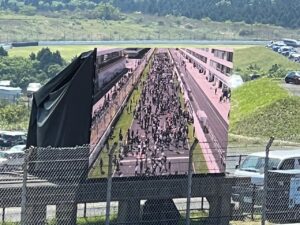
We arrived at the track at 12 noon. The super lites were having their third race of the weekend at 12:30. The main event of the entire weekend with the headliner Super Formula group started at 3 p.m.
We were most surprised at how many people made their way to the event given the really chancy roads for the last 20 miles of driving they got us to the track. They must have come very early or possibly camped at the track from the day before. Given the track’s location, they had a very good crowd.
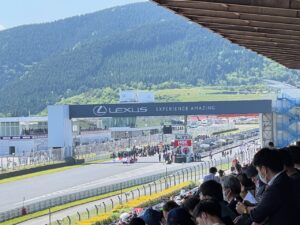
The Japanese people do things that are just a little bit different from how you would see things in the United States. One of those is that it is impolite to eat or drink in public. You won’t see any Japanese people walking down a city sidewalk, drinking a bottle of water or a can of Coca-Cola, or eating an ice cream cone.
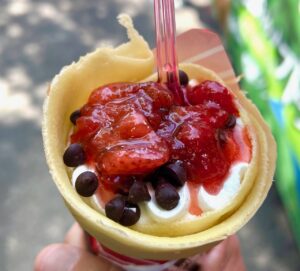
Today it seemed as if Japanese fans bought various food selections but in almost no cases had anything to drink. Even the vendors offered almost nothing to drink with their food offerings. We had to use one of the drink vending machines to get something to quench our thirst. We ended up eating Japanese-style burritos that were essentially bacon, eggs, and lettuce, wrapped in a crêpe, not a tortilla. Of course, we had an ice cream treat to finish off our racing culinary day. The ice cream was served inside a crepe and not a cone.
Another thing that you’ll be hard-pressed to find in Japan is trash containers. I guess if you’re not walking up and down the street with a can of soda and eating a McDonald’s hamburger, you’re going to have a lot less trash than a normal person.
I called these trips “trackchasing trips”. I often tell Carol there is not a lot of “track” in her trackchasing trips. We’ve been on the road for 11 days doing all kinds of things that are unique to Japan. Our trip included being at a racetrack for about four hours out of those 11 days. Yes, it’s a trackchasing trip because we saw Super Formula racing at the Autopolis International Racing Circuit. Racing was a big reason we were in Japan at this time of the year. Nevertheless, the four hours we spent at the track accounted for less than 1% of all of the time we spend in Japan. I’m good with that.
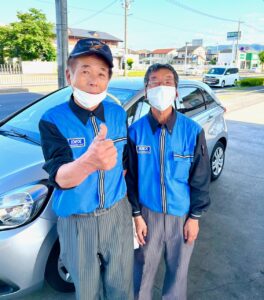
When the racing was finished, we pulled into a Japanese gas station. From what I could tell they appeared to offer the same kind of full service that you might have noticed as a child if you grew up in the 50s and early 60s. The older guys helping us were a stitch. I could tell they loved the “novelty” of Americans pulling into their station. We all bonded immediately.
In five hours, we had driven 149 miles. It seemed more than that. Our fuel expense came in at $4.67 a gallon in U.S. terms. With those 149 miles of driving, we used 10.8 liters of fuel. That meant our little Honda Fit gave us 50.5 miles per gallon. I’ll take that!

On the way back to the city we stopped at a highway rest area. This stop was surprisingly like a stop at a United Kingdom Welcome Center. They had a store selling all kinds of Japanese food and souvenirs. We wanted to buy several items but our luggage was already stuffed to 110% maximum!
I was just happy to be able to get the rental car returned safely. We did have the insurance. If I had totaled the car, we wouldn’t have had to pay anything but I didn’t want to take advantage of that particular benefit.
Tomorrow we continue our trip with a flight back to Tokyo. I can confidently say that virtually everything we have planned has come to fruition. That is not always the case with these trips. We’ve just been lucky that everything that we wanted to do and see has fit into our schedule just fine.
Tomorrow, Carol and I will both fly from Fukuoka back to Tokyo. We will stage overnight in a hotel at Tokyo’s Narita Airport. Then we both head in different world directions from Japan. I’ll tell you about that soon.
MONDAY
We’re leaving Fukuoka today. Heading back home is going to take Carol a couple of days. I’m not going back to San Clemente. I’ve got another week of touring. Carol’s limit for these trips is about two weeks. It’s really ten days but I always try to “extend” her.
We hopped on a Jet Star Japan flight from Fukuoka to Tokyo’s Narita airport. I can highly recommend Jetstar Japan.
Jet Star’s fares are super cheap. The planes looked brand new inside. The flight attendants did a good job. I have flown on Jet Star in Australia as well. Jet Star is a discount carrier but they don’t feel like they are.
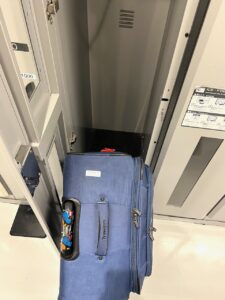
When we landed in Narita the big objective at that particular moment was retrieving our two bags that we had stored in lockers at the airport. This process went much smoother than getting the bags stowed in the lockers, to begin with.
For storing about 60 pounds of luggage, the fee for a bit more than three days was around $50 U.S. That was cheaper than if we had tried to check the bags from Tokyo to Fukuoka and back. I know it was a lot more convenient for us not to have to lug around that extra luggage as we already have plenty as it was.
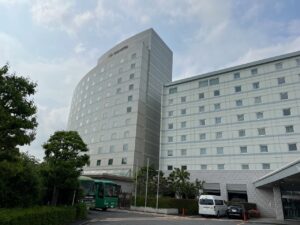
Tonight, we were staying at the Narita Tobu Airport Hotel. For some odd reason, hotel prices at modern high-rise properties around the Narita Airport were extremely inexpensive. We ended up paying just $81 for this hotel.
Although the hotel had a shuttle from the airport, we decided to walk. This was a good choice as the walking distance was only about half of a mile. It took us just nine minutes to complete the journey.
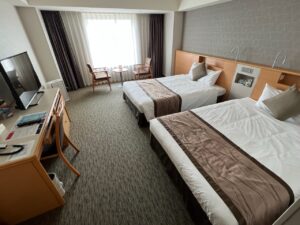
Once in the hotel, our mission was to mix and match and organize all of our bags which now included lots of dirty clothes and the like. I like to remind Carol that this shouldn’t be that difficult to do. We only have so many bags and everything simply needs to go in one of those bags. As a husband, I always feel my advice is invaluable. To be honest I’m not sure Carol sees each nugget I share as being as worthwhile as I do!
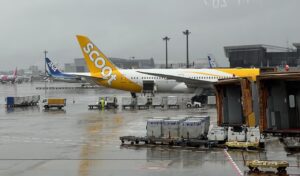
Tomorrow Carol will fly on a nonstop flight from Tokyo’s Haneda airport to Los Angeles. I will be flying on an airline called “Scoot” from Tokyo’s Narita airport to Singapore. Carol’s flight home is twelve hours long. My flight to Singapore is scheduled for six hours. I have just a one-hour and 40-minute connection for my next flight continuing on to Perth, Western Australia. That will be a five-hour plane ride. I would have thought Tokyo was much closer to Perth than 11 hours of flight time.
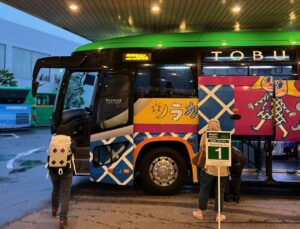
I’ve got a question for you. Could your spouse or significant other get themselves from the hotel to the Narita airport with baggage that weighs twice what they do and then ride a one-hour shuttle bus from one airport in this case Narita to the next airport in this case, Haneda, and then fly 12 hours to their final destination in this case Los Angeles? Carol can do that. I’m happy about that. I’m proud of her.
I was continuing on to Western Australia to do some trackchasing in the northern part of this Australian state. I’ll tell you more about that as we go along.
This has been an excellent trip. We had so many logistical things that could’ve gone wrong but not this time. I just hope our streak of good luck can continue all the way until both Carol and I get back to our modest seaside cottage.

I’m traveling with just a single 22-inch rolling bag and a computer briefcase. I’ll be in Australia for a week. I’m going to have to check my rolling bag as a requirement by the airline. I never like checking bags. I really don’t like checking bags when I have a connection. My scheduled connecting time through Singapore was one hour and forty minutes. We left Tokyo late and that reduced our connecting time in Singapore to just 50 minutes. Would my bag make it? I was concerned.

I’ll be flying all day wearing a T-shirt and shorts. At the racing locations I’m planning to visit in Western Australia the weather expect is expected to be chilly in the evenings. That being the case I jammed two days’ worth of clothing into one of my UCLA sweatshirts. I will stealthily carry that on the plane. If my rolling bag doesn’t catch up with me, at least I’ll have two days’ worth of clothing which isn’t much but it’s better than nothing.
TUESDAY
I was out the door very early to catch a 5 a.m. hotel shuttle to the airport. I had a long day of flying ahead of me.

Carol would leave a bit later. She had to catch an airport limousine bus from Tokyo’s Narita Airport to Tokyo’s Haneda Airport. I don’t like it when there are so many moving parts for someone else, in this case, Carol, to navigate. I do this every week. I think I can handle moving parts a little bit better than most folks. I was fearful that if her plan started to jump the tracks that could be a problem for her. I worried about her all day long. She had not “turned her phone on” during our two-week trip at all. She was instructed to call me if she had any problem whatsoever with a flight delay or anything else. I wasn’t exactly sure what I could have done for her immediately since I would be on a plane today for eleven hours myself.
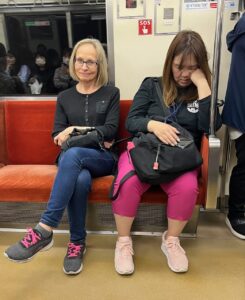
In closing, I am happy to report that Carol made it to LAX. Upon landing our son J.J. met her and made sure that she and her 150 pounds of luggage made it to the parking garage. She was valuable cargo. In the meantime, my plane was landing late at night in Perth, Western Australia. Yes, we lead some unique travel lives. No problem there. We are volunteers in all of this!
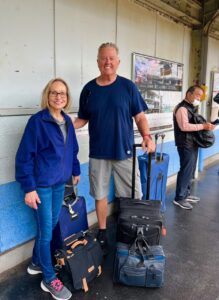
Randy Lewis and his long-time travel companion Carol

